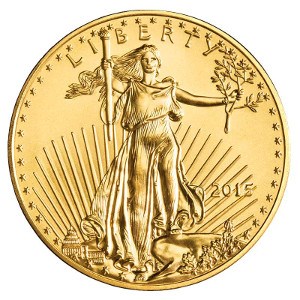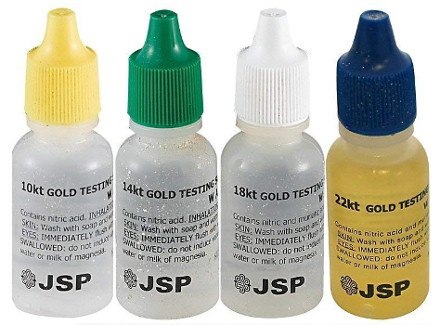Gold is an expensive commodity that is often faked. If you own gold but you're not sure about its authenticity, then it's a good idea to test it. With the methods below you will be able to tell if your gold is real. You can combine these tests in order to be more accurate.
For Any Type of Gold
The tests below work for any type of gold.
Acid Test
The acid test is the most effective method. This test requires you to make a small indent on your item, because some items are only gold-plated. So don't do this test on gold coins, jewelry with aesthetic value, or jewelry that you want to keep for yourself.
First you need to buy an acid kit. These kits are inexpensive and they will last you a long time. Once you have your acid then it's time to test.
First make a small scratch on your item- it's easiest to do this with a nail file. Then put a few drops of nitric acid on the indent. If there was no reaction then your gold is real. If your item changes a different color then it's not going to be pure gold.
Color changes happen when the acid reacts to different metal alloys such as copper, zinc, and sterling silver. If you see a light green color then your item is probably gold plated over a base metal such as copper or zinc. If there is a white colored reaction then your item is probably gold-plated over sterling silver, which is known as gold vermeil.
Instead of scratching your item you could also rub it against a testing stone to leave a mark. You would then drop the acid on the stone.
Remember: Always make sure to closely follow the instructions from your testing kit.
Liquid Foundation Test
This test is not as reliable as the acid test, but it's still fairly effective. To get started you just need to put liquid foundation on your forehead. Next take your gold item and rub it on the foundation. If you see a black streak then your item is probably real gold.
You can also do this test on someone who has an iron deficiency. It's the same process- just rub the item across the forehead. The hemoglobin from the blood will elevate and create a black mark if the gold is real.
Ceramic Test
This test can potentially damage your item. Therefore it's best to only do it with items that don't have aesthetic value.
To get started you will need a piece of unglazed ceramic. Rub your item across the ceramic in order to make a streak of color. If you see a gold streak then it's probably real gold. If you see a black streak then it's probably fake gold.
Eye Test
This is an easy test to see if your item is gold-plated. If your gold jewelry has been worn numerous times then it's possible that you could see some discoloration on the surface. So if the gold coating has worn off then you could see the base layer, which could be an inexpensive metal such as copper, zinc, nickel, etc.
You can also look at the color of your item. If your piece of jewelry is a really intense color then it could be plated with 24 karat gold. Gold is a relatively soft metal so jewelry is not likely to be made with pure 24k gold. It's more often mixed with an alloy to make it more durable. That's why 14k and 16k are much more common for jewelry.
It's best to use a jeweler's loupe to get a closer look at your jewelry.
Density Test
Here is a simple test- drop your gold item into a a jug of water. Gold is a heavier metal so if your item floats then it's not going to be real gold. If it sinks then it could be real gold. This test is a good way to quickly discover fakes.
Magnet Test
This is another test that can quickly identify fakes. It's not the best test for jewelry because magnetic metals can be used with gold jewelry. Also the clasp could be magnetic.
All you need to do is hold your gold item up to a strong magnet. We recommend using a rare earth magnet. Gold is non-magnetic so if it sticks then it's not real. If your item doesn't stick then it could be real gold, but you would need to do further tests to verify.
Bite Test

The bite test will leave a mark on your item, so only do this test for scrap gold and items with zero aesthetic value. Also be aware that you could potentially hurt your teeth.
If you've ever watched the Olympics then you've probably seen some Olympians bite down on their gold medals. This is called the bite test, as you can bite down on gold to see if it's real. Gold is a softer metal so if your bite leaves teeth marks, then it could be real gold.
However this test is not the most accurate because the outcome can depend on the type of gold. 10K and 14K are mixed with more alloys so they will be harder. Also a fake could pass this test because there are other soft metals out there. For example, lead is softer than gold.
Shower Test
This is a great test for gold jewelry. All you need to do is wear your gold chain, gold bracelet, or gold ring in the shower. If it fades, tarnishes, or rusts then it's not real gold.
Pin Test
The pin test is good for scrap gold. Pick an area on your item that is not likely to be noticed. With a needle or pin, scratch at the surface and see if any specs of gold come off. If specs come off then your item is gold-plated.
For Gold Coins
The two tests below are for gold coins. They are the best tests for gold coins because your coin will not be damaged.
Weight Test
A 1oz gold coin should weigh a little over 1oz. The reason for it being over one ounce is that gold is a softer metal so an additional metal alloy is added to make it harder.
Specifications Test
This is an easy test but it will require some research. The first step is to look up the exact specifications of your coin. The second step is to compare those specifications to the coin in question.

Here are the specifications for the American Gold Eagle coin:
| Denomination: | $50.00 |
| Date: | 1986 to Present |
| Quality: | Uncirculated, Proof, Bullion |
| Weight: | 1.0909 troy ounces (33.930 grams) |
| Diameter: | 1.2874 inches (32.70 mm) |
| Thickness: | 0.113 inches (2.87 mm) |
| Edge Type: | Reeded |
If possible it's best to compare coins that were minted in the same year.
When comparing the weight you will need a calibrated gram scale. The scale should be accurate to at least one tenth of a gram. If the weight of your item is off by over two grams then it's definitely a fake.
Conclusion
Some people think they can tell gold's authenticity by looking for a stamp such as 14k, 24k, etc. Please know that this is not a reliable test. It's easy enough for anyone to stamp a piece of fake jewelry and then pass it off as real. Stick with the tests that we listed above, especially the acid test.
You can always try to take your gold to a jeweler to have it tested, but you will need to trust the jeweler. Some jewelers will do this service for free, while others will charge you a fee. So if you know a reputable jeweler then it's best to call ahead of time and ask what their policy is.
In addition if you have silver then be sure to read our article on how to authenticate silver. Many of the authentication techniques are the same, but there are some techniques exclusive to silver.

